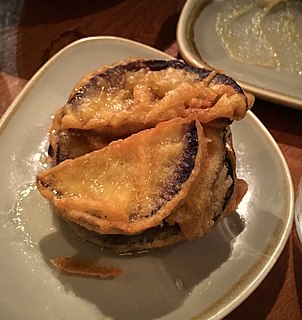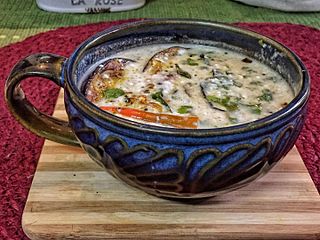
Turkish cuisine is largely the heritage of Ottoman cuisine, which can be described as a fusion and refinement of Mediterranean, Balkan, Middle Eastern, Central Asian, Eastern European, Armenian, and Georgian cuisines. Turkish cuisine has in turn influenced those and other neighbouring cuisines, including those of Southeast Europe (Balkans), Central Europe, and Western Europe. The Ottomans fused various culinary traditions of their realm with influences from Mesopotamian cuisine, Greek cuisine, Levantine cuisine, Egyptian cuisine, Balkan cuisine, along with traditional Turkic elements from Central Asia, creating a vast array of specialities.

Eggplant, aubergine or brinjal is a plant species in the nightshade family Solanaceae. Solanum melongena is grown worldwide for its edible fruit.

Baba ghanoush, also spelled baba ganoush or baba ghanouj, is a Levantine appetizer consisting of mashed cooked eggplant, olive oil, lemon juice, various seasonings, and sometimes tahini. It may be served with onions, tomatoes, or other vegetables. The eggplant is traditionally baked or broiled over an open flame before peeling, so that the pulp is soft and has a smoky taste. It is a typical meze ('starter') of the regional cuisine, often served as a side to a main meal and as a dip for pita bread.

Moussaka is an eggplant- or potato-based dish, often including ground meat, which is common in the Balkans and the Middle East, with many local and regional variations.

Thai eggplant is the name for several varieties of eggplant used in Southeast Asian cuisines, most often of the eggplant species Solanum melongena. They are also cultivated in India and Sri Lanka and feature in Sri Lankan cuisine. These golf ball sized eggplants are commonly used in Thai cuisine, Indonesian cuisine, and in Cambodian Cuisine. Some of the cultivars in Thailand are Thai Purple, Thai Green, Thai Yellow, and Thai White.

Eggplant is a dark purple or brownish-purple color that resembles the color of the outer skin of European eggplants. Another name for the color eggplant is aubergine.

Parmigiana, also called parmigiana di melanzane[parmiˈdʒaːna di melanˈdzaːne; -ˈtsaːne], melanzane alla parmigiana[melanˈdzaːne; -ˈtsaːne ˌalla parmiˈdʒaːna], or eggplant parmesan is an Italian dish made with fried, sliced eggplant layered with cheese and tomato sauce, then baked. The origin of the dish is claimed by both the Southern regions of Campania and Sicily. Other variations found outside Italy may include chicken, veal, or another type of meat cutlet or vegetable filling.

Kuwaiti cuisine is a fusion of Arabian, Iranian, and Mesopotamian cuisines. Kuwaiti cuisine is part of the Eastern Arabian cuisine. A prominent dish in Kuwaiti cuisine is machboos, a rice-based dish usually prepared with basmati rice seasoned with spices, and chicken or mutton.

Many cuisines feature eggplant salads and appetizers.

Patlıcanlı kebap is a Turkish kebab that may be prepared according to various traditions.

Baingan bharta is a South Asian dish prepared by mincing grilled eggplant (baingan) and mixing it with tomato, onion, herbs and spices. Grilling the eggplant over charcoal or direct fire infuses the dish with a smoky flavour. Mashed eggplant is then mixed with cooked chopped tomato, browned onion, ginger, garlic, cumin, fresh cilantro, chili pepper, and mustard oil or a neutral vegetable oil. Traditionally, the dish is often eaten with flatbread and is also served with rice or raita, a yogurt salad. In Bihar and Uttar Pradesh, it is served hot with litti or baati.

The Lao eggplant, also known as Lao aubergine, is a local variety of eggplant found in Laos and used primarily in Lao cuisine. Common cultivar types in Laos are Lao Green Stripe, Lao Purple Stripe, Lao Lavender, and Lao White. They are usually round and roughly the size of a golf ball.

Fried eggplant is featured in dishes of many different cuisines.

Malidzano is a traditional Macedonian spread made from puréed bell peppers, eggplant, oil, salt and mustard (optional). It derives its name from the Italian word for eggplant, melanzane. Malidzano is usually served as an appetizer with a side of bread like spread and piece of white cheese. In other countries of Western Balkans, it is prepared with both green or red peppers so the color of the spread depends from that.

Dahi baigana is an Odia dish prepared from dahi (yogurt) and eggplant especially during festivals. This dish can be prepared without using onion and garlic when they are not allowed in some auspicious festivals.

Stuffed eggplants are a dish typical of many countries.
Eggplant papoutsaki is an eggplant dish of the Greek cuisine and Turkish cuisine. "Papuc" or "papuç" is a Persian word "paposh" (پاپٯش) that is also used in Turkish and has the meaning of "shoe" or "slipper". The basic dish consists of eggplants which have been boiled or roasted and the tops cut off lengthwise,. The flesh is scooped out and mixed with other ingredients, sometimes ground beef, sometimes eggs, green peppers or bell peppers, green onions, tomatoes, lemon, and olive oil. It is topped with a hard, salty cheese such as kefalotyri, Mihaliç Peyniri or kasseri and grilled.

Tortang talong, also known as eggplant omelette, is an omelette or fritter from Filipino cuisine made by pan-frying grilled whole eggplants dipped in an egg mixture. It is a popular breakfast and lunch meal in the Philippines. A common variant of tortang talong is rellenong talong, which is stuffed with meat, seafood, and/or vegetables.

Poqui poqui, also spelled puke puke or puki puki, is a Filipino eggplant and scrambled eggs dish originating from the Ilocos Region of Northern Luzon in the Philippines. It is very similar to tortang talong in that the eggplant is first grilled directly on an open flame, then peeled and mashed. It is then added to ginisa and scrambled eggs. It is garnished with spring onions. It has a creamy texture and is usually eaten as a side dish to grilled fish and meat dishes, but it can also be eaten with white rice. It is believed that the name of poqui poqui may have originated from the Hawaiin dish poke due to the influx of Ilocano sugarcane workers to Hawaii during the American colonization of the Philippines, although they are very different dishes.





























